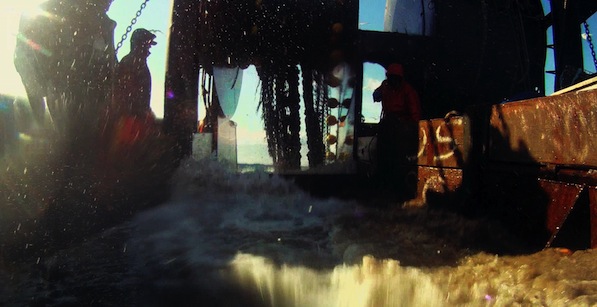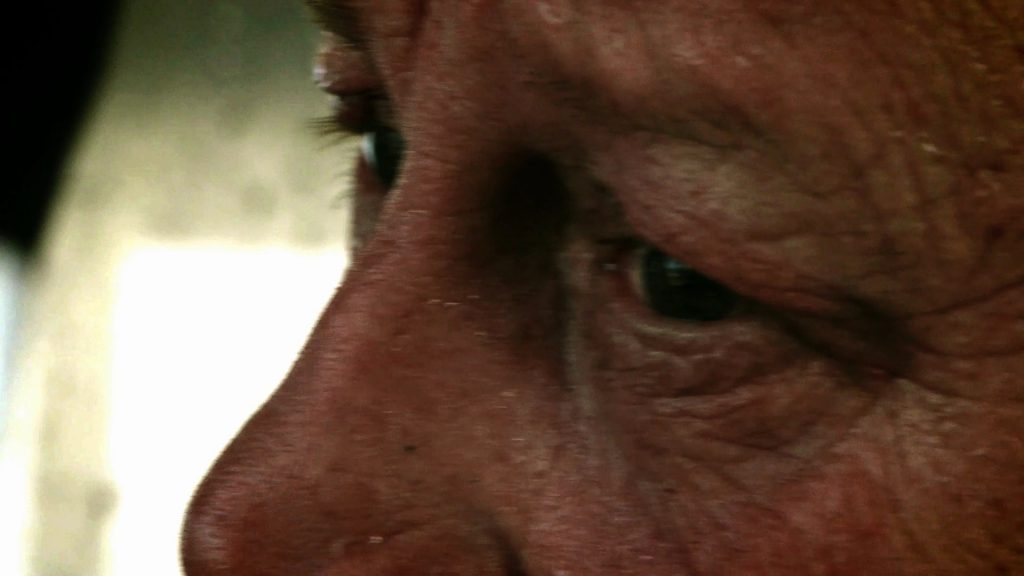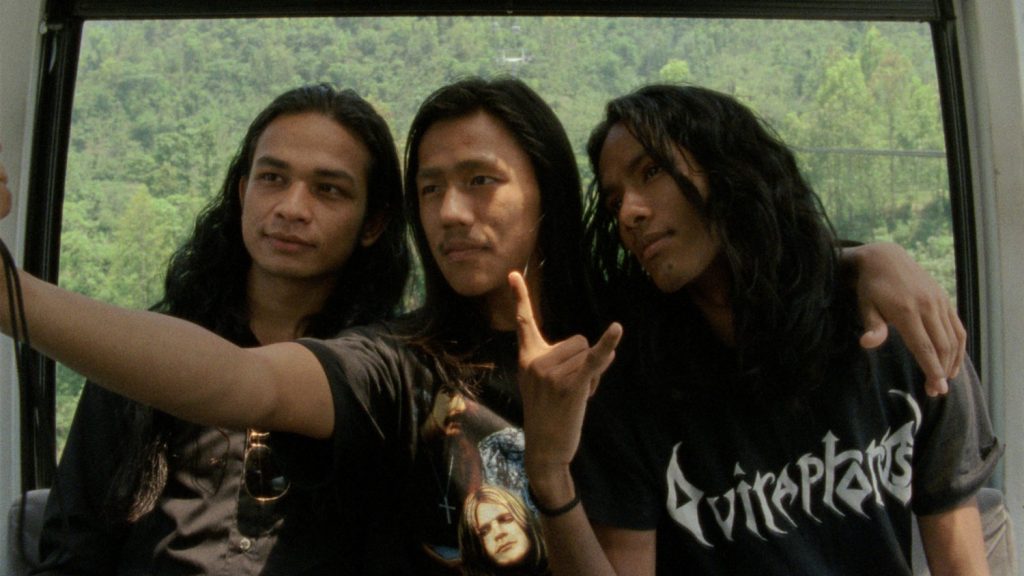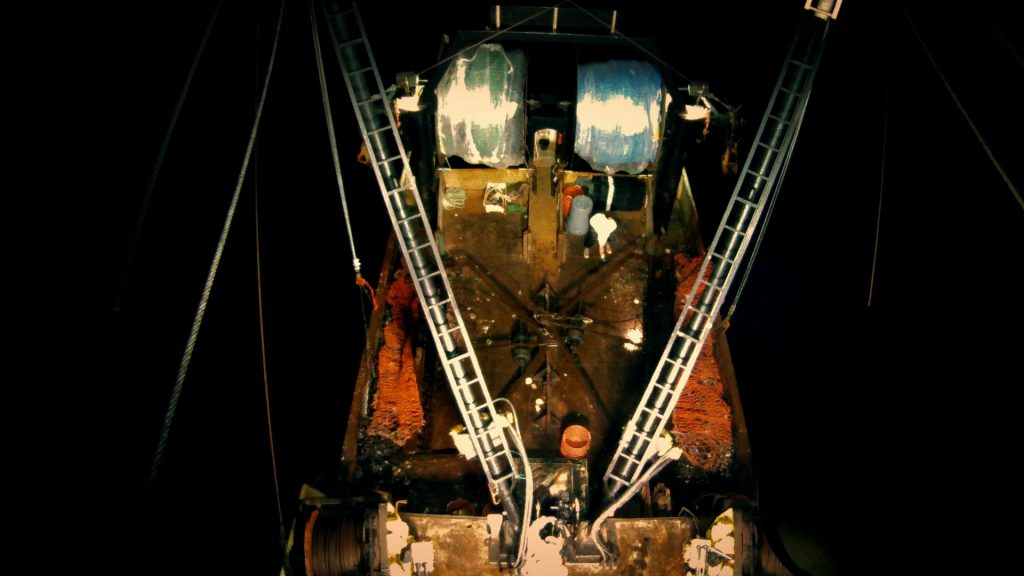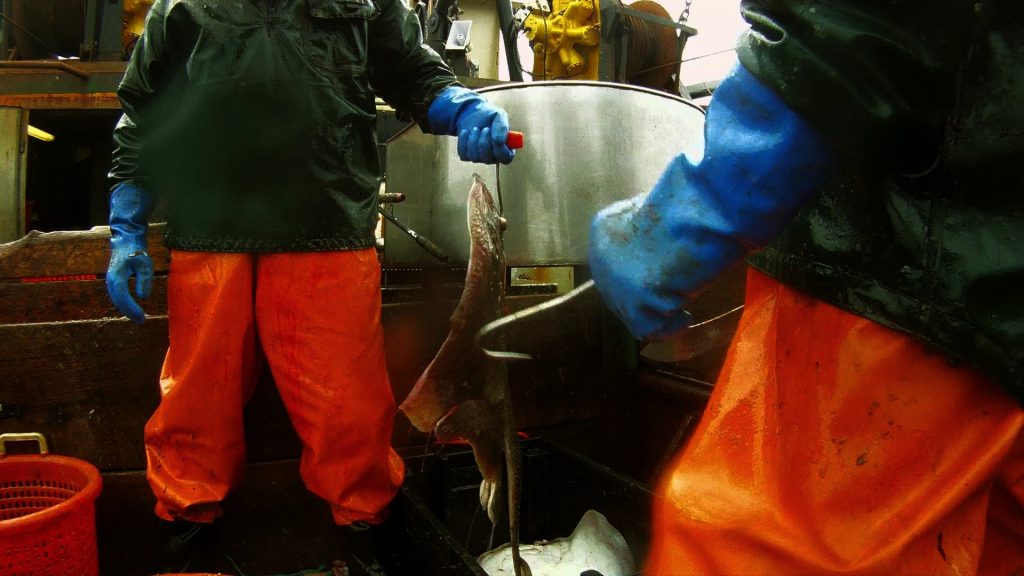In an attempt to understand the workings of Harvard’s Sensory Ethnography Lab–the experimental anthropology hub headed up by Lucien Castaing-Taylor and Ernst Karel that fosters “innovative combinations of aesthetics and ethnography”—a reliance on the written word may prove to be the least productive of approaches. The department offers up a collective and thus far astonishing body of work by faculty and students as a form of evidence through praxis, which uniquely attests to rather than clearly defines the program’s stated goal of seeking “an attention to the many dimensions of the world, both animate and inanimate,” via a keen deployment of audiovisual media. Sweetgrass (2009), the unsentimental pastoral directed—or “recorded” —by Castaing-Taylor and Ilisa Barbash, which adhered with unprecedented vigilance to the imminently extinct labor of cowboy sheep herders and their wayward flocks in the wild mountain passes of the American West, manifested a documentary ethos that opposed journalistic and theatrical tendencies in favor of an embodied awareness. The resultant film destabilized critical reception in the plein de monde milieu of proper cinema; here was a film less conducive to “reading” so much as experiencing, such was its rather paradoxical effect of yielding forcefully to nature. The film more than altered a hegemonic documentary genre, it reconfigured the very habitat in which director and subject interfaced, where human and animal became less conveniently distinguishable.
If such claims on behalf of the filmmakers’ purported intent or the film’s perceived impact seem inflated, it is worth bearing in mind that the very impetus of SEL’s endeavors is inherently resistant to overstatement, that as active engagements they resist criticism that confers equations of success or failure, that an attention to the dimensions of the world requires first and foremost a kind of humility, but backed by execution that entails an element of valour. Leviathan, an uncannily sumptuous monstrosity of a film more discovered than made by Castaing-Taylor and Véréna Paravel, ostensibly about commercial fishing off the New England coast, could be mistaken as an act of bravado for what is deemed to be its disregard for certain audience expectations, facile legibility, mimetic representation, and that beleaguered precept of documentary practice, didacticism. Castaing-Taylor’s rejoinder to a question about the film’s intent at a press conference at the New York Film Festival starkly reframes the parameters of his practice:
“Films like anything that humans make are always about something in some way. But to imagine that they are about something that could be expressed in words outside the fabric of the film itself is kind of ludicrous ’cause then you wouldn’t make the film, you’d write it. But fiction films in particular, narrative films, are not reducible to a point, or to making a statement about the world. And non-fiction documentary suffers by contrast with this burden that spectators put on it, that filmmakers put on it…. which is that it’s always elaborating an argument about the world, it’s reducible to making a statement about the world, it’s usually a political or evaluative statement. And to imagine that the whole swath, the whole domaine of reality, of everything that is non-fiction, is divested of its plenitude, of its richness, of the whole experiential sensory qualities of actually being in the world, of lived experience itself, so that they can be reduced to meaning, can be encapsulated in language, in prose, is such a travesty…”
As seemingly radical are the means by which Leviathan is rendered—namely an “arsenal” of both consumer and professional cameras and microphones often put literally out to sea—the methodology is in many ways a continuation of cinema verite’s inception, in particular Jean Rouch’s dictum that “making a film means making it with your eyes, your ears, and with your body.” Just as the loss of Rouch’s tripod in the Niger facilitated a hand-held immediacy that invigorated his material and collapsed an appreciable distance from his subjects, it was in losing precious cameras to open waters that Castaing-Taylor and Paravel arrived at the pragmatic poetry afforded by encased GoPro cameras, tethered from handmade poles and cast overboard, registering spectral and disorienting images of sea birds filigreed upon slate skies while diving headlong as if for prey. As with any potentate, the sea intoxicates and repels, to which Leviathan can at best surrender through holistic immersion.
While the SEL anticipates a potentially new era in documentary practice, perhaps as Barcelona’s Master’s course at Pompeu Fabra did in the early 2000s, a historical continuum can be drawn from filmmaker/anthropologist Robert Gardner, who pioneered the production and research unit at Harvard that became The Film Study Center, a twin engine to SEL that is now also directed by Castaing-Taylor. Gardner’s Forest of Bliss (1986) and Dead Birds (1963) alone warrant reconsideration, celebration even, amid the current climate of Sundance docs that take broadcast journalism as a kind of template. So too the SEL can be seen as re-investing in anthropologist Jay Ruby’s seminal 1975 essay “Is An Ethnographic Film a Filmic Ethnography?” in which he theorizes that “[by] blindly following the conventions of documentary film, and by relying upon the written/spoken word to ‘anthropologize’ their images, ethnographic filmmakers are demonstrating the lack of conventions for creating image/sound structures which will be interpreted, in and of themselves, as being anthropological or even scientific.”
However profoundly informed by academia, the work issuing from the SEL is by definition fieldwork, i.e. constitutively visual or acoustic: it engages with the world. To suggest that these films’ cumulative appeal outside of a theoretical/institutional context lies within arthouse cinema (with the festival circuit as its incubator) may help their visibility, but at the expense of SEL’s dynanism. A pervasive discourse rippling at the edges of non-commercial cinema at once describes and influences a certain tendency for formal ambiguity in which narrative films partake of, lapse into, non-fiction elements, creating a hybrid genre all the more sustaining for straddling both worlds (the films of Lisandro Alonso, Valerie Massadien, Pedro Gonzalez-Rubio, Pedro Costa, Albert Serra, Apichatpong Weerasethakul, among others, bear this out). By contrast, the films produced in the SEL possess a stranger-than-fiction quality on account of their insistence on (what the course material describes as) the “affective fabric of human and animal existence.” In this regard both the narrative films typified by their “in-betweenness” and the irreality conjured by the SEL recordings harmonize on the Bazinian concept of every film being in essence a form of social documentary; although it is to the SEL’s credit that this is an organic process more than a willful aesthetic conceit.
Thus any branding of the SEL runs contrary to the program’s intent, in spite of temptations to herald the work under a common rubric that unifies any aesthetic. The recent Viennale has been the first international festival to take up the cause, presenting a special program of key works from the SEL entitled Wild Ethnography, in which a certain heterogeneity of material, as well as an inclination for collaboration, is clearly evident. When pressed to elaborate on the workings of the SEL, the exceedingly articulate Castaing-Taylor remains quiet, as if to imply that the work generated from the lab speaks for itself and is the most faithful indicator of its goals. I’m curious whether, if the works succeed in the terms laid out in the course description, that these imperatives are relatively ignored by the critical sector, i.e. the “film community” (some reactions to Leviathan, for instance, suggest that the film is more an insular indulgence than an expansive commitment, which an understanding of its unique ethnographic approach could conceivably reverse). “I really don’t like talking about the SEL,” discloses Castaing-Taylor. “I don’t trust myself. I have nothing to say. But to the extent that it’s worth paying attention to at all, much better if folks like you do than we be allowed to propagandize ourselves.”
I first met Castaing-Taylor at the screening of Sweetgrass at the 2009 Vancouver International Film Festival, where in interview he was more forthcoming about the genesis of his practice, itself an arsenal of approaches that at the time registered as calmly subversive and even outside of experimental film grammar, though the film could be imaginatively read as an ethnographic variation on the Western, in sheep’s clothing. International film culture could catch up to Sweetgrass or ignore it at its peril, but the the film, and by extension the SEL, was scarcely reliant on the culture of cinema for exegesis. In this sense the work of the SEL is frighteningly relevant for reporting back from the world without definitive agendas or affiliations, devoted rather to non-artifactual encounters with the lived world that have ontological implications rather than quantitative findings.
A subsequent invitation to visit the SEL in Cambridge proved to be of little visual anthropological interest. “There’s nothing to see at SEL” warned Castaing-Taylor, “computers, monitors, flatbeds.” There are no machines rendering ontological implications, no processors of exegesis, not even theoretical lab coats. But leave it to the lab’s manager Ernst Karel, a composer and lecturer in anthropology, who has contributed to much of SEL’s output as a sound recordist, mixer and designer, to have subjected a bulk of the chemistry lab’s equipment and activity to unprocessed recordings in an attempt to foreground the physical processes underlying scientific research (in Heard Laboratories). “One can not be at the same time all eye and all ear” said Robert Bresson, and it is clear that Karel is the ears of the department, attuned to the resonances of the heard world, which are too often neglected or suppressed in the gathering of visually priveleged media. Leviathan is Heavy Metal in spirit—channeling an abrasive heavy rock sensibility that was the hull’s soundtrack—but also, quite literally, it is of heavy metal, as Karel and sound designer Jacob Ribicoff unsparingly transmit the sonic battery of the vessel, the clamor of rippling chains flogging briny armour, rendered palpably menacing.
Karel’s Swiss Mountain Transport Systems (2011) sonically charts various gondola, funicular and transverse-seat chairlift passages from 2005–2008, and structurally anticipates SEL student/teachers Stephanie Spray and Pacho Velez’s Manakamana (2013), a film that unfolds exclusively within the cable cars delivering passengers to the famed temple in Nepal. Before a screening (on a monitor) of a rough cut, Castaing-Taylor is excited about the film’s potential: “My guess is it could be the best thing to have come out of the SEL.” High praise indeed, coming from the co-creator of the Lab’s most salient specimens yet. Beside cartons of Chinese take-out and a bottle of red wine are copies of Hobbes’ Leviathan and Melville’s Moby Dick, comprising a tableau that reveals the ordinary human workings of the lab (Castaing-Taylor’s beagle has been exiled to an adjacent room, so as not to disturb). Manakamana, clocking in at three hours, proves mundanely majestic, scaled like a minimalist masterpiece that reveals itself proportionately to the time you spend with it (akin to wandering an abandoned gymnasium repurposed with Donald Judd sculpture at the Chinati foundation). There’s also a sequence that is side-splittingly funny and utterly unforced, quite possibly one of the most sustained sight-gags imaginable within the confines of documentary, which plays like a real-time satire on the Nepalese discovery of ice cream.
Castaing-Taylor’s concern over how to sequence the film’s chapter-like long takes was ultimately borne out in the final cut, which premiered at the Locarno Film Festival and garnered the Filmmakers of the Present award for Spray and Valez. Spray, who is a Teaching Fellow at the SEL, had been working extensively in Nepal with her previous SEL projects As Long As There’s Breath (2009), Monsoon Reflections (2008), and Kāle and Kāle (2007), from which she would ultimately “cast” Manakamana‘s assorted pilgrims (a strategy which lends a decidedly performative element to the film’s seemingly droll procession of bodies resting in motion). Velez, a Fellow at the Film Study Center, considers himself an outsider looking in, who studied at Cal Arts and distinguishes between the respective approaches of the two schools: “I think that what the SEL does that other graduate schools don’t do or, at least, don’t insist upon, is the dual focus on anthropology and filmmaking. At CalArts, as often as not, the search is for a good subject, and then a strong way to represent that subject. At Harvard, the range of subjects is much more circumscribed (usually) by prior ethnographic fieldwork. So the question becomes much more how to best represent a given subject, not what subject to select. It’s the old artist’s dialectic about limitations being liberating.
“There are other things that connect the [SEL] films—a lack of interest in exposition and traditional ‘story beats,’ a commitment to carefully-recorded ambient sound, a belief in long-takes, a focus on single locations (a boat, a cable car, a demolition site). But J.P. Sniadecki’s Chinese films seem very much to stem from his prior regional involvement, as does Stephanie’s work in Nepal, and many of the newer students in the lab as well. Their films are able to go deep because the students speak the language of the country in which they are working, they have developed social networks within those countries, and they’ve invested time, sometimes years, in nurturing those local relationships.”
A professor at Cornell University as well as graduate student of the SEL, Sniadecki co-directed with Paravel the acclaimed portrait of a despoiled industrial zone of Willets Point in New York, Foreign Parts (2010), an ethnography that salvages dignity from the denizens scrapping for existence in the face of imminent demolition, in the shadow of the Mets baseball stadium. A similar strategy is employed in a range of films that chronicle public space and effects of industrialization in China—Yumen (2013), People’s Park (with Libbie D. Cohn, 2012), The Yellow Bank (2010), Demolition (Chiaqian, 2008), and Songhua (2008)—which together form some of the most elucidating inquiries into life in modern China, alongside the work of Jia Zhangke and Wang Bing. Curiously, synopses of Sniadecki’s films often employ the usage of the word attend, as close a summation to what, and how, they negotiate a non-hierarchical schema of director, subject, and habitat. Yumen, co-directed with Chinese artists Xu Ruotao and Huang Xiang, is poised to point documentary in a new direction yet, imagining its abandoned former oil-drilling town as a platform for wandering souls, while the very film stock on which it was recorded feels as ghostly as the forlorn landscape. Narrative gesture becomes entwined in the very fabric of the real, where post-industrial “ruin porn” is threaded with social(ist) realism, Asian pop, and performance art. It is, like much of the SEL output, sui generis.
When the cinema does finally take its last breath, history may very well reflect generously upon the determination evinced by the SEL’s dogged pursuits, but for now there is no abiding take-away other than life, lived. Ultimately, the SEL posits the real as nothing less than fundamentally intractable. Like the elusive biblical water beast that cannot be drawn out with a hook, the untamed natural world can not be reflected to any degree of revelation without commensurately wild or becalmed forms. Having stared into the belly of the beast, and comprehensively engaged its contours, we might merely realize that the serpent is kind, compared to man.

